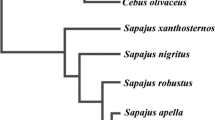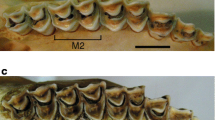Abstract
The spread of grasslands and cooling climate in the Miocene contributed to an increasingly abrasive diet for ungulates. This increase in abrasiveness is proposed to select for both hypsodonty and increasing complexity of occlusal enamel bands. If these traits evolved in response to strong selection to resist tooth wear while feeding in grassland habitats, we might expect them to have evolved in a correlated fashion. If, on the other hand, there was a developmental or physiological constraint, or if selection was not strong on total enamel production, we would expect species to have evolved one or the other of these traits at a time, producing an uncorrelated, or even inversely correlated, pattern of trait evolution. To test these hypotheses, we examined the Occlusal Enamel Index (OEI) and Hypsodonty Index (HI) of 773 ungulate teeth. We tested the dependence of OEI on HI for the orders Artiodactyla and Perissodactyla using phylogenetic generalized least squares regression (PGLS). The two traits are not significantly correlated in the PGLS, for Artiodactyla and Perissodactyla. Despite their physical proximity, close functional utility, and conventional correlation, our results reject the hypothesis that HI and OEI are evolutionarily linked in these lineages, suggesting that selection to resist tooth wear was not so strong as to drive the overall evolutionary trajectory of both these traits at the same time.


Similar content being viewed by others
References
Badenhorst S, Plug I (2003) The archaeozoology of goats, Capra hircus (Linnaeus, 1758): their size variation during the last two millennia in southern Africa (Mammalia: Artiodactyla: Caprini). Ann Transvaal Mus 40:91–121
Bair AR (2007) A model of wear in curved mammal teeth: controls on occlusal morphology and the evolution of hypsodonty in lagomorphs. Paleobiology 33:53–75
Bair AR (2011) Description of a new species of the North American archaic pika Hesperolagomys (Lagomorpha: Ochotonidae) from the middle Miocene (Barstovian) of Nebraska and reassessment of the genus Hesperolagomys. Palaeontol Electron 14:6A:49p
Bapst DW (2012) paleotree: an R package for paleontological and phylogenetic analyses of evolution. Methods Ecol Evol 3: 803–807. doi:10.1111/j.2041-210X.2012.00223.x
Damuth J, Janis CM (2011) On the relationship between hypsodonty and feeding ecology in ungulate mammals, and its utility in palaeoecology. Biol Rev 86:733–758. doi: 10.1111/j.1469-185x.2011.00176.x
Dassule HR, Lewis P, Bei M, Maas R, McMahon AP (2000) Sonic hedgehog regulates growth and mophogenesis of the tooth. Development 127:4775–4785
Famoso NA, Davis EB (2014) Occlusal enamel complexity in middle Miocene to Holocene equids (Equidae: Perrisodactyla) of North America. PLoS ONE 9(2):e90184. doi: 10.1371/journal.pone.0090184
Famoso NA, Feranec RS, Davis EB (2013) Occlusal enamel complexity and its implications for lophodonty, hypsodonty, body mass, and diet in extinct and extant ungulates. Palaeogeogr Palaeoclimatol Palaeoecol 387:211–216. doi: 10.1016/j.palaeo.2013.07.006
Felsenstein J (1985) Phylogenies and the comparative method. Am Nat 125:1–15
Forsten A (1975) Fossil horses of the Texas Gulf Coastal Plain: a revision. Pierce-Sellards Series. Texas Memorial Museum 22:1–86
Fraser D, Rybczynski N (2014) Complexity of ruminant masticatory evolution. J Morphol 275:1093–1102. doi: 10.1002/jmor.20284
Fritz SA, Bininda-Emonds ORP, Purvis A (2009) Geographical variation in predictors of mammalian extinction risk: big is bad, but only in the tropics. Ecol Lett 12:538–549
Garland T, Dickerman AW, Janis CM, Jones JA (1993) Phylogenetic analysis of covariance by computer simulation. Syst Biol 42:265–292
Garland T, Harvey PH, Ives AR (1992) Procedures for the analysis of comparative data using phylogenetically independent contrasts. Syst Biol 41:18–32
Grafen A (1989) The phylogenetic regression. Phil Trans Roy Soc B 326:119–157
Harjunmaa E, Kallonen A, Voutilainen M, Hämäläinen K, Mikkola ML, Jernvall J (2012) On the difficulty of increasing dental complexity. Nature 483:324–327. doi: 10.1038/nature10876
Harvey PH, Pagel MD (1991) The Comparative Method in Evolutionary Biology. Oxford University Press, Oxford
Heywood JJN (2010) Functional anatomy of bovid upper molar occlusal surfaces with respect to diet. J Zool 281:1–11
Hoppe KA, Stover SM, Pascoe JR, Amundson R (2004) Tooth enamel biomineralization in extant horses: implications for isotopic microsampling. Palaeogeogr Palaeoclimatol Palaeoecol 206:355–365. doi: 10.1016/j.palaeo.2004.01.012
Hulbert RC (1988a) Calippus and Protohippus (Mammalia, Perissodactyla, Equidae) from the Miocene (Barstovian–early Hemphillian) of the gulf coastal plain. Bull Florida State Mus Biol Sci 32:221–340.
Hulbert RC (1988b) Cormohipparion and Hipparion (Mammalia, Perissodactyla, Equidae) from the late Neogene of Florida. Bull Florida State Mus Biol Sci 33:229–338.
Hulbert RC (1993) Taxonomic evolution in North American Neogene horses (subfamily Equinae): the rise and fall of an adaptive radiation. Paleobiology 19:216–234
Janis CM (1988) An estimation of tooth volume and hypsodonty indices in ungulate mammals, and the correlation of these factors with dietary preference. In: Russell DE, Santoro JP, Sigogneau-Russell D (eds) Teeth Revisited: Proceedings of the Seventh International Symposium on Dental Morphology, Paris 1986. Mem Mus Natl Hist Nat C, Paris, pp 367–387
Jardine PE, Janis CM, Sahney S, Benton MJ (2012) Grit not grass: concordant patterns of early origin of hypsodonty in Great Plains ungulates and Glires. Palaeogeogr Palaeoclimatol Palaeoecol 365–366:1–10. doi: 10.1016/j.palaeo.2012.09.001
Jordana X, Marín‐Moratalla N, Moncunill‐Solé B, Köhler M (2014) Ecological and life‐history correlates of enamel growth in ruminants (Artiodactyla). Biol J Linn Soc 112:657–667
Kaiser TM, Fickel J, Streich WJ, Hummel J, Clauss M (2010) Enamel ridge alignment in upper molars of ruminants in relation to their diet. J Zool 81:12–25
Kelly TS (1998) New middle Miocene equid crania from California and their implications for the phylogeny of the Equini. Contrib Sci Nat Hist Mus Los Angeles County 473:1–43
Louys J, Ditchfield P, Meloro C, Elton S, Bishop LC (2012) Stable isotopes provide independent support for the use of mesowear variables for inferring diets in African antelopes. Proc Roy Soc B-Biol Sci 279:4441–4446
Kuhn TS, Mooers AØ, Thomas GH (2011) A simple polytomy resolver for dated phylogenies. Methods Ecol Evol 2:427–436. doi: 10.1111/j.2041-210X.2011.00103.x
MacFadden B J (1998) Equidae. In: Janis CM, Scott KM, Jacobs LL (eds) Evolution of Tertiary Mammals of North America, Volume 1: Terrestrial Carnivores, Ungulates, and Ungulatelike Mammals. Cambridge University Press, New York, NY, pp 537–559
MacFadden BJ (1994) Fossil Horses: Systematics, Paleobiology, and Evolution of the Family Equidae. Cambridge University Press, New York
MacFadden BJ (1988) Fossil horses from “Eohippus” (Hyracotherium) to Equus; 2. Rates of dental evolution revisited. Biol J Linn Soc 35:37–48
MacFadden BJ (1984) Systematics and phylogeny of Hipparion, Neohipparion, Nannippus, and Cormohipparion (Mammalia, Equidae) from the Miocene and Pliocene of the New World. Bull Am Mus Nat Hist 179:1–195
Martins EP, Garland T (1991) Phylogenetic analysis of the correlated evolution of continuous characters: a simulation study. Evol 45:534–557
Meachen J (2005) A new species of Hemiauchenia (Artiodactyla, Camelidae) from the late Blancan of Florida. Florida Mus Nat Hist Bull 45:435–447
Mendoza M, Palmqvist P (2008) Hypsodonty in ungulates: an adaptation for grass consumption or for foraging in open habitat? J Zool 274:134–142
Mihlbachler MC, Rivals F, Solounias N, Semperbon GM (2011) Dietary change and evolution of horses in North America. Science 331:1178–1181. doi: 10.1126/science.1196166
Molnar S, Gantt DG (1977) Functional implications of primate enamel thickness. Am J Phys Anthropol 46:447–454. doi: 10.1002/ajpa.1330460310
Orme D, Freckleton R, Thomas G, Petzoldt T, Fritz S, Nick I (2011) Caper: comparative analyses of phylogenetics and evolution in R. R package version 0.4. Available from: http://CRAN.R-project.org/package=caper
Price SA, Hopkins SSB (2015) The macroevolutionary relationship between diet and body mass across mammals. Biol J Linn Soc 115:173–184. doi: 10.1111/bij.12495
Pagel M (1997) Inferring evolutionary processes from phylogenies. Zool Scr 26:331–348
R Core Team (2013) R: A language and environment for statistical computing. R Foundation for Statistical Computing, Vienna, Austria. URL http://www.R-project.org/
Revell LJ (2010) Phylogenetic signal and linear regression on species data. Methods Ecol Evol 1:319–329. doi: 10.1111/j.2041-210X.2010.00044.x
Salazar-Ciudad I, Jernvall J (2013) The causality horizon and the developmental bases of morphological evolution. Biol Theory 8:286–292
Sponheimer M, Reed KE, Lee-Thorp JA (1999) Combining isotopic and ecomorphological data to refine bovid paleodietary reconstruction: a case study from the Makapansgat Limeworks hominin locality. J Hum Evol 36:705–718
Tummers M, Thesleff I (2003) Root or crown: a developmental choice orchestrated by the differential regulation of the epithelial stem cell niche in the tooth of two rodent species. Development 130:1049–1057. doi: 10.1242/dev.00332
Van Valen L (1960) A functional index of hypsodonty. Evolution 14:531–532
Acknowledgments
We would like to thank the UO Paleontology Group and the UO Department of Geological Sciences for feedback and support related to this project. We would like to thank the University of California Museums of Vertebrate Zoology and Paleontology, Florida Museum of Natural History, Burke Museum of Natural History and Culture, John Day Fossil Beds National Monument, American Museum of Natural History, the Smithsonian’s U.S. Museum of Natural History, and University of Nebraska State Museum for access to collections. We would also like to thank John Wible and two anonymous reviewers for their constructive reviews of this manuscript. This paper was partly funded by NSF DEB-1256894-0.
Author information
Authors and Affiliations
Corresponding author
Electronic Supplementary Material
Below is the link to the electronic supplementary material.
Online Resource 1
R code used to execute analyses. Both the code for the artiodactyl and perissodactyl PGLSs are included (PDF 16 kb)
Online Resource 2
File for 101 dated artiodactyl phylogenies. This is a .nex file class = “multiphylo” when used for analysis in R (PDF 547 kb)
Online Resource 3
File for the perissodactyl phylogeny. This is a .nex file class = “phylo” when used for analysis in R (PDF 44 kb)
Online Resource 4
First and last occurance dates for the perissodactyls phylogeney. This file should be .csv when used for analysis in R (PDF 104 kb)
Online Resource 5
OEI and HI data for the artiodactyl PGLSs. This file should be .csv when used for analysis in R (PDF 106 kb)
Online Resource 6
OEI and HI data for the perissodactyl PGLS. This file should be .csv when used for analysis in R (PDF 104 kb)
Rights and permissions
About this article
Cite this article
Famoso, N.A., Davis, E.B., Feranec, R.S. et al. Are Hypsodonty and Occlusal Enamel Complexity Evolutionarily Correlated in Ungulates?. J Mammal Evol 23, 43–47 (2016). https://doi.org/10.1007/s10914-015-9296-7
Published:
Issue Date:
DOI: https://doi.org/10.1007/s10914-015-9296-7




